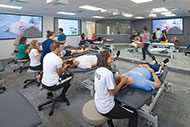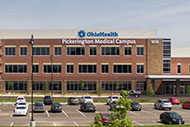Saint Barnabas Medical Center recently unveiled a new five-story, 241,000-square-foot addition to its Livingston, N.J., medical center that was designed with input from patients, family members and staff.
The new Cooperman Family Pavilion is the cornerstone of a campus transformation at Saint Barnabas Medical Center, a flagship facility of RWJBarnabas Health.
With its towering glass entrance, the pavilion will become the new point of entry for all patients and visitors to the medical center. The beautiful, natural light-infused building reflects evidence-based approaches to promoting healing and improving care.
The pavilion will encompass 114 new private rooms and an expansive 56-bassinet neonatal intensive care unit (NICU), which is five times the size of the previous NICU.
It also provides spaces for outpatient diagnostic services, including noninvasive cardiology, cardiopulmonary and neurodiagnostics lab, endoscopy lab and preadmission testing; a central registration area; and a same-day surgery suite lounge. A new three-story parking garage can accommodate more than 400 vehicles.
"The Cooperman Family Pavilion was designed specifically to create a more comfortable and healing environment for our patients, one that encourages families and caregivers to be active participants in the healing process," says Stephen Zieniewicz, president and CEO, Saint Barnabas Medical Center.
The private rooms can accommodate a family member for an overnight stay and many rooms have floor-to-ceiling windows to let in natural light, Zieniewicz says. Family conference areas and waiting rooms are available to provide privacy.
“All of these amenities are critical in offering the most comforting environment to stimulate healing," he explains.
In designing the Cooperman Family Pavilion, the design team worked with the project architects, under the direction of Francis Cauffman, and researched industry best practices on family-centered care.
Patients, family members, community members, physicians and staff all provided design input to reduce the risk of falls, decrease noise, increase natural lighting, increase access to patients and provide a welcoming, homelike environment.
The result was design details such as curb-free showers to prevent falls, use of acoustical materials to lessen noise and hybrid operating suites that allow surgeons to transfer easily from minimally invasive to open procedures.
The plan for the NICU was influenced by the patient advisory council, which brings together former patients' families for their perspective on how to provide better care and services to families in that unit.
Based on this information, the NICU will have a series of single rooms in a pod design that allows families to bond with their babies within a few steps of nearby medical staff.
Two new family rooms offer parents the opportunity to stay overnight and care for their baby within the hospital environment prior to their discharge, further reducing anxiety and facilitating the transition home.
"We understood the value of speaking with our patients and families about what they wanted and needed in a hospital environment," Zieniewicz says.
"The project has truly been collaborative and I firmly believe we have the right amenities, structures and state-of-the-art technologies to provide the ultimate in patient care for our communities for the future," he notes.
Want to see your new health care construction project featured on HFM Daily? Email project information and photos to Senior Editor Jeff Ferenc or tweet to him @JeffFerenc.





